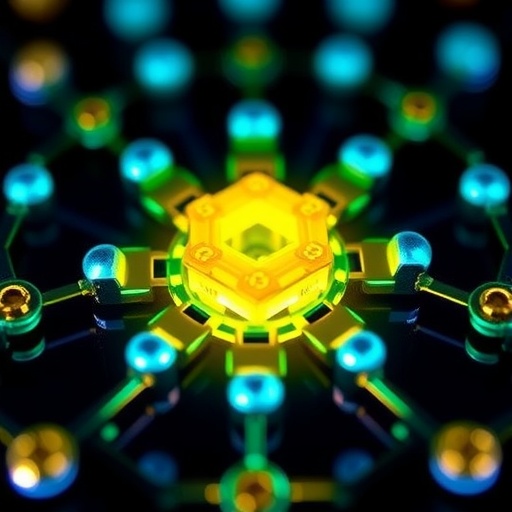In the realm of material science, the phenomenon of mechanoluminescence—the emission of light from materials subjected to mechanical action—has long been observed predominantly in crystalline structures. Dating back to the 17th century when Francis Bacon described the sparks produced by fracturing hard sugar in darkness, this luminous display has intrigued scientists aiming to harness these striking effects for practical use. However, the requirement for rigid crystalline frameworks traditionally imposed severe limitations, particularly because fracture-induced light emission also leads to the deterioration of the material’s mechanoluminescent capabilities. Now, pioneering research from the Okinawa Institute of Science and Technology (OIST) is rewriting the rules by demonstrating mechanoluminescence in amorphous, crystal-free materials, opening avenues for more durable and flexible applications.
The longstanding dogma held that mechanoluminescence arises from the fracturing of crystalline lattices, where the breaking of bonds under mechanical stress liberates energy as light. These mechanical stimulations, such as grinding or rubbing, cause structural disruption in crystal lattices, which correlates to light emission. However, such mechanisms inherently limit the lifespan and practicality of mechanoluminescent materials due to progressive damage. This dependence on precise crystal packing and structure led researchers at OIST to explore alternatives that would bypass these structural constraints.
Headed by Professor Julia Khusnutdinova from the Coordination Chemistry and Catalysis Unit at OIST, the research team embarked on a quest to develop mechanoluminescent materials that do not rely on crystalline integrity. Their approach centered on amorphous films composed of heteroleptic copper complexes—molecules previously known for their photoluminescent properties but traditionally not for mechanoluminescence. By fabricating thin films devoid of crystallinity, the researchers challenged the notion that crystal fracture is a prerequisite for light emission under mechanical stress.
The study, recently published in the prestigious journal Chemical Science, showcases detailed experimental methodologies wherein various mechanical stimuli including twisting, rubbing, and contact separation techniques were applied to these amorphous copper complex films. Remarkably, these manipulations induced significant mechanoluminescence, visually confirmed as bursts of light without any structural compromise to the film. This contrasts sharply with crystal-based systems, where mechanical stress would induce damage and degrade luminescence over time.
A key to this breakthrough is the underlying mechanism of electrification—the generation of localized electric fields as mechanical energy is converted within the material. In these crystal-free films, mechanical stimulation does not fracture the material; instead, it induces surface charge separation, which excites both the luminescent molecules and the ambient gas environment, causing light emission. The researchers ingeniously demonstrated that such excitation could occur non-destructively beneath a protective plastic coating, preserving the material’s integrity while maintaining visible luminescent output.
This discovery fundamentally challenges previously held assumptions about mechanoluminescence’s dependency on crystal breakage. Dr. Ayumu Karimata, lead author of the study, emphasized this paradigm shift: “We have proved that crystal fracture is not necessary for mechanoluminescence. This liberates materials design from complicated crystal engineering constraints and ushers in a new class of flexible, durable mechanoluminescent systems.”
The implications of these findings are far-reaching. By eliminating the reliance on crystalline frameworks, these amorphous materials possess greater durability and longevity, thereby overcoming a critical bottleneck that has traditionally undermined mechanoluminescent devices’ viability. This advancement has tangible applications in industrial engineering, where materials can be designed to emit light as a direct response to mechanical stress, serving as real-time indicators of wear or damage without the risk of irreversible material failure.
Moreover, the flexibility of these films suggests potential integration into wearable technologies or safety devices, where gentle mechanical interactions could trigger visual signals vital for user feedback and hazard warnings. Unlike rigid crystals, these amorphous films can conform to surfaces of varying shapes and undergo repeated mechanical stimulation without deteriorating performance—a property highly desirable for next-generation sensing materials.
The research team further points out that the synthetic accessibility and versatility of heteroleptic copper complexes open a broad design space for tuning emission wavelengths and intensities to suit specific applications. Such materials can be customized chemically to optimize their luminescent responses under different environmental conditions, thereby expanding their utility.
Beyond practical applications, this study deepens our fundamental understanding of mechanoluminescent phenomena. By decoupling the emission from physical fracturing, the researchers provide new insights into the role of electric field-driven excitation and charge transfer processes in amorphous systems. These findings could stimulate more theoretical and experimental research aimed at uncovering novel stimuli-responsive behaviors in other non-crystalline luminophores.
The research, while still in its early stages, suggests that future work could explore integration with electronics or microfabrication techniques, potentially enabling the development of smart materials that combine mechanoluminescence with additional functionalities such as conductivity or catalysis.
In conclusion, OIST’s demonstration of mechanoluminescence from amorphous copper complex films driven by non-destructive mechanical stimulation marks a significant milestone in materials science. This innovation sets the stage for the emergence of flexible, durable, and customizable luminescent materials with exciting prospects across technological domains ranging from industrial safety systems to consumer electronics. As the boundaries of mechanoluminescence broaden beyond crystalline paradigms, the future of light-emitting materials under mechanical influence looks more versatile and promising than ever before.
Subject of Research: Not applicable
Article Title: Mechanoluminescence from amorphous solids of heteroleptic copper complexes and common luminophores induced by non-destructive mechanical stimuli and fabrication of flexible mechanoluminescent films
News Publication Date: Not specified
Web References: http://dx.doi.org/10.1039/D5SC05673J
References: Published in Chemical Science
Image Credits: Ayumu Karimata/OIST
Keywords
Mechanoluminescence, Amorphous materials, Heteroleptic copper complexes, Photoluminescence, Non-destructive mechanical stimuli, Flexible films, Electric field excitation, Triboluminescence, Material durability, Stimuli-responsive materials, Material science, Industrial safety applications
Tags: advancements in non-crystalline materialscrystal-free mechanoluminescencedurability of mechanoluminescent materialsexploring new material propertiesflexible materials in material scienceinnovative applications of mechanoluminescencelight emission from non-crystalline structuresmechanical action light emissionmechanoluminescence in amorphous materialsOIST research on materials sciencepractical uses of mechanoluminescenceProfessor Julia’s contributions to mechanoluminescence





